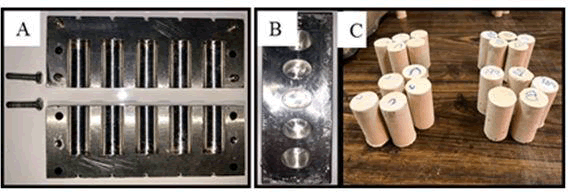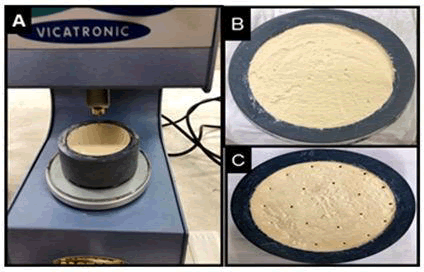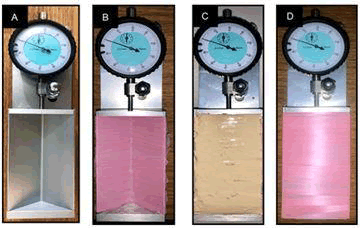Research Article - (2021) Volume 9, Issue 12
Evaluation of Some Properties of Dental Stone After Incorporation of Bergamot Essential Oil
Ghassan Abdul-Hamid Naji1* and Layth Taher Omer2
*Correspondence: Ghassan Abdul-Hamid Naji, Department of Prosthetic Dentistry, University of Baghdad, Baghdad, Iraq, Email:
Abstract
Introduction: Due to its proven antimicrobial efficiency, bergamot essential oil was incorporated into dental stone mixture to enhance the material by yielding a disinfected cast, however such property enhancement should not be accompanied by jeopardizing others in order to make sure of the material’s usability.
Aims: The study was aimed to evaluate some properties of type III dental stone that include diametral tensile strength, initial setting time and linear setting expansion after the incorporation of bergamot essential oil.
Materials and Methods: A total of 90 specimens, 30 for each test with dimensions of 20 ± 0.2 mm in diameter and 40 ± 0.4 mm in thickness for diametral tensile strength test, 70 mm in diameter at top, 60 mm in diameter at bottom and 40 mm high for initial setting time test and 100 ± 0.1 mm length shaped as isosceles triangle with a 90° angle and internal side lengths of 30 ± 1 mm for linear setting expansion test were prepared by incorporation of various percentages of 8% and 10% of bergamot essential oil (by volume) and 0% as a control group. Dental stone specimens were tested 1 hour from the start of the mix for the diametral tensile strength, 2 min before the mix lost its sheen for the initial setting time till the needle fail to penetrate the mix up to 2 mm and 60 ± 1 sec prior to initial setting time for the linear setting expansion till 2 hours after.
Results and Discussion: The incorporation has a significant increase increased both the diametral tensile strength and the linear setting expansion (P<0.00), while reduced the initial setting time (P<0.00). Such results may be due to reduction in liquid/powder ratio that has not been compensated by the incorporation because of the essential oil’s volatile nature.
Conclusion: The incorporation of bergamot essential oil revealed an improvement in the diametral tensile strength and linear setting expansion, while reducing the initial setting time of dental stone.
Keywords
Bergamot essential oil, Dental stone Type III, Diametral tensile strength, Initial setting time, Linear setting expansion
Introduction
Dentistry may be served by gypsum materials more predominantly as compared to other materials, their major role can be summarized as pouring material characterized by its compatibility with all impression materials to yield a positive replica whether a study model, master cast or die. One of the gypsum materials is type III dental stone that is mainly utilized for pouring casts, on which orthodontic appliances or prosthetic dentures to be fabricated. One of the researchers goal regarding infection control is to manage the cross-contamination occurring between dental patients and dental personnel especially dental laboratory personnel, for which dental impression act as a source, while dental cast as a medium. Despite the fact that sterilization is almost always required, all its means threaten to sacrifice the accuracy of both dental impression and cast, on the other hand disinfecting the dental impression is not always the best option due the evolved difficulties and complications, as an alternative dental stone disinfection had been suggested by many researchers in such a way that incorporating a certain disinfectant into the mixing liquid of dental stone to act as a potent antimicrobial agent while persevering other properties of material at acceptable range. Bergamot essential oil was selected because of its antibacterial and anti-fungal properties against many infectious species such as staphylococcus aureus and candida albicans. The present study evaluated the influence of bergamot essential oil on some properties of type III dental stone. The antimicrobial efficiency of the essential oil had been established in other study. Hence this study is concerned with its effect on diametral tensile strength, initial setting time and linear setting expansion properties after incorporation of two concentrations 8% and 10% in addition to comparing with 0% as control [1].
Materials and Methods
Diametral tensile strength test was carried out diametral tensile strength value was calculated indirectly from the maximum load applied in compression by the utilization of Instron universal testing machine. A clean, dry split mold was utilized for specimens preparation, constructed corrosion-resistant, non-absorbent stainless steel sufficient to produce 5 cylindrical specimens of dental stone measuring 20 ± 0.2 mm in diameter and 40 ± 0.4 mm high [2]. The mold halves were guided into position by four guide pins and secured by two screws. The inner surfaces of the mold were coated with a thin layer of non-reacting mold releasing agent. Dental stone was mixed according to manufacturer’s instructions at a powder / liquid ratio of 0.3 (30 g / 100 mL). The mix was poured down the side of the inclined-placed mold until slightly overfilled while being gently vibrated for 30 sec in order to minimize air bubbles entrapment. Then the mix was leveled before loss of gloss in order to be flush with the top of the mold by placing a glass plate firmly into contact in order to produce equal and parallel flat specimen’s tops [3]. About 45 ± 1 min later from start of mixing, mold halves were split and specimens removed and stored in ambient air at 23 ± 2°C and relative humidity of 50 ± 10%. After 60 ± 1 min from the start of mixing, specimens were tested by placing them in a diametral fashion so that increasing compressive load delivered by the flat metallic surfaces was applied through the specimen’s diameter until failure occurred at a rate of 5 ± 2 KN/min. The maximum load applied was utilized to calculate the value of diametral tensile strength for each specimen involved from the formula as follows: diametral tensile strength =2P/πDT, where P is the maximum load applied, D is the specimen’s diameter, T is the specimen’s thickness (Figure 1).

Figure 1: Split mold utilized for specimen’s preparation for diametral tensile strength test; (A) The split; (B) The assembled; (C) Dental stone specimens.
Initial Setting time test was performed following the revised American national standards/American dental association standards No. 25-20154 by using digital vicat apparatus/Vicatronic, Matest, Italy, which in turn allows the analysis of initial setting time through the insertion of a metallic needle with a diameter of 1 ± 0.05 mm and a length of 50 mm, coupled to a vertically mobile rod, under a total mass of 300 ± 1g. A ring mold constructed from corrosion-resistant, non-absorbent material measuring of 70 mm in diameter at top, 60 mm in diameter at bottom and 40 mm height, to be placed on the base plate of the apparatus, within which the dental stone mixture was poured then tested. The ring mold was coated with a thin layer of non-reacting mold release agent. Dental stone was mixed according to manufacturer’s instructions at a liquid/powder ratio of 0.3, then was poured into the mold while being gently vibrated for 30 sec in order to minimize air bubbles entrapment, the mold was overfilled then the mix was leveled to be flush with the top of the mold, the timer utilized during mixing was left running in order to be as a reference for subsequent times [4]. The mold was placed on the base plate of the apparatus under the needle, the test was run automatically 2 min before the mix lost its sheen, allowing for complete needle penetration, following which successive insertions in different regions were carried out every 15 seconds. Initial setting time stands for the time spent between the start of the mixing and the point when the needle could not pierce the mass up to 2 mm (Figure 2).

Figure 2: (A) Vicatronic apparatus with test in progress; (B) the ring mold filled with leveled dental stone mixture; (C) dental stone specimen at the end of the test.
Linear setting expansion test was performed following the revised American national standards/American dental association standards No. 25-20154 by using extensometer apparatus / plaster extensometer, Matest, Italy, with a triangular cross-section trough made of non-corroding, non-absorbent metallic material, that produces a specimen length of 100 ± 0.1 mm, the apparatus is fitted with a dial gauge device which has a maximum measuring force of 0.8 N and measures changes in length to within 0.01 mm precision. The trough's internal cross section is an isosceles triangle with a 90° angle and internal side lengths of 30 ± 1 mm, one end of the trough is blocked with an immovable end-piece and the other with movable end-piece having a mass capacity of 100 ± 10 g. Trough floor and sides were completely lined with polytetraflurouethelene, then the non-reacting mold release agent was applied to the trough end-pieces that conduct the material being tested, the movable end-point was placed in position so that a length measuring 100 ± 0.1 mm was established and was locked in that position while adjusting the dial gauge at zero. Dental stone was mixed according to manufacturer’s instructions at a liquid/powder ratio of 0.3, and poured until the trough was overfilled then the mix was leveled with the top surface, followed by wrapping the trough with the polytetraflurouethelene, then the locking screw of the movable end-piece is released, the test started 60 ± 1 sec prior to the initial setting time. Linear Setting expansion was calculated from the formulas as follows: L0 = Lf − ︎ΔL, % ADL = ΔL/L0 × 100, when L0 is the initial length, Lf is the final length, ΔL is the change in length and % ADL is the percentage of alteration in length (Figure 3).

Figure 3: (A) Plaster extensometer apparatus; (B) floor lining with polytetraflouroethelene; (C) overfilled trough with leveled dental stone mixture; (D) wrapping the trough with polytetraflouroethelene.
Results
The results of diametral tensile strength test after 1 hr of specimen’s preparation revealed that both 8% and 10% concentrations had a higher mean value than the 0%, and the 10% incorporation revealed the highest mean value of 5.48 MPa. The descriptive statistics and statistical test of results utilizing one-way ANOVA for comparison of mean values are listed in (Table 1).
Table 1: Descriptive and statistical test of diametral tensile strength, utilizing one-way ANOVA.
| Groups | N | Mean (MPa) | Minimum | Maximum | ±SD | P-value |
|---|---|---|---|---|---|---|
| 0% BEO | 10 | 4.76 | 4.17 | 5.38 | 0.43 | |
| 8% BEO | 10 | 5.24 | 4.34 | 5.9 | 0.43 | 0.00 (HS) |
| 10% BEO | 10 | 5.48 | 4.85 | 5.92 | 0.33 |
df=2
Levene’s test=0.54
The difference a was highly significant (P<0.01). Tukey’s HSD test was carried out as a post hoc test to compare the means between each two concentrations, it revealed a significant difference between 0% and 8% (P<0.05), a highly significant difference between 0% and 10% (P<0.01), while a non-significant difference between 8% and 10% (P>0.05). The findings of initial setting time test revealed that both 8% and 10% concentrations had a lower mean value than the 0%, and the 10% incorporation revealed the lowest mean value of 11.5 min. The descriptive statistics and statistical test of results utilizing one-way ANOVA for comparison of mean values are listed in (Table 2).
Table 2: Descriptive and statistical test of initial setting time, utilizing one-way ANOVA.
| Groups | N | Mean (min) | Minimum | Maximum | ±SD | P-value |
|---|---|---|---|---|---|---|
| 0% BEO | 10 | 14.48 | 13.5 | 15.75 | 0.69 | |
| 8% BEO | 10 | 12.53 | 11.25 | 13.75 | 0.77 | 0.00 (HS) |
| 10% BEO | 10 | 11.5 | 10.75 | 12.5 | 0.6 |
df=2
Levene’s test=0.1
The difference was highly significant (P<0.01). Tukey’s HSD test was carried out as a post hoc test to compare the means between each two concentrations, it revealed a highly significant difference between each two ones (P<0.01) [5]. The outcome of linear setting expansion test after 2 hrs of specimens preparation revealed that both 8% and 10% concentrations had a higher mean value than the 0%, and the 10% incorporation revealed the highest mean value of 0.05%. The descriptive statistics and statistical test of results utilizing one-way ANOVA for comparison of mean values are listed in (Table 3).
Table 3: Descriptive and statistical test of linear setting expansion, utilizing one-way ANOVA.
| Groups | N | Mean (%) | Minimum | Maximum | ±SD | P-value |
|---|---|---|---|---|---|---|
| 0% BEO | 10 | 0.02 | 0.01 | 0.03 | 0 | |
| 8% BEO | 10 | 0.03 | 0.02 | 0.04 | 0 | 0.00 (HS) |
| 10% BEO | 10 | 0.05 | 0.04 | 0.06 | 0 |
df=2
Levene’s test=0.00
The difference was highly significant (P<0.01). Tukey’s HSD test was carried out as a post hoc test to compare the means between each two groups, it revealed a significant difference between 0% and 8% (P<0.05), a highly significant difference between 0% and 10% and also between 8% and 10% (P<0.01).
Discussion
In the present study, the finding of diametral tensile strength increase can be attributed to the fact that the diametral tensile strength is directly proportional to the compressive strength, which is inversely proportional to liquid/powder ratio of the mix, the less the liquid utilized in the mixing process (until certain point), the higher the compressive strength because of reduction in the porosity, also reduction in voids and porosity generally provides a denser dental stone structure, such an increase in density leads to a higher compressive strength value which in turn result in higher diametral tensile strength, however, the incorporation of 8% and 10% of bergamot essential oil may have compensated for such liquid reduction, but such compensation appeared to be incompletely effective may be due to the volatile nature of almost 93-96% of its constituents, as a result such an increase has occurred comparable to that occurring in case of liquid/powder ratio reduction. This finding is in disagreement with Breault et al. (1998) who concluded that partial substitution of mixing liquid with 5.25% sodium hypochlorite has no effect on diametral tensile strength, while Abdelaziz et al. (2002) and Pradeep et al. (2017) concluded that partial substitution of mixing liquid with various disinfectants each at time result in reducing diametral tensile strength due to the alteration of the crystals structure which in turn hinders their intermeshing ability. In the present study, the finding of initial setting time is in agreement with Breault et al. (1998) who concluded that partial substitution of mixing liquid with 5.25% sodium hypochlorite significantly decrease the initial setting time. Such a decrease can be attributed to the fact that the setting time is inversely proportional to liquid/powder ratio of the mix, the less the liquid utilized in the mixing process (until certain point), the shorter the setting time, however, the incorporation of 8% and 10% of bergamot essential oil may have compensated for such liquid reduction, but such compensation appeared to be incompletely effective may be due to the volatile nature of almost 93-96% of its constituents, as a result a shortening in initial setting time has occurred comparable to that occurring in case of liquid/powder ratio reduction.
-In this study, the finding of linear setting expansion is in agreement with sabouhi et al. (2014) conclusions which stated that the incorporation of calcium hypochlorite increased the setting expansion of dental stone. Such an increase can be attributed to the fact that setting expansion is inversely proportional to liquid/powder ratio of the mix, the less the liquid utilized in the mixing process (until certain point), the higher the setting expansion, however, the incorporation of 8% and 10% of bergamot essential oil may have compensated for such liquid reduction, but such compensation appeared to be incompletely effective may be due to the volatile nature of almost 93-96% of its constituents, as a result an increase in linear setting expansion has occurred comparable to that occurring in case of liquid/powder ratio reduction. This finding is in disagreement who revealed that either no effect or slight reduction in linear setting expansion occurred depending on the disinfectant utilized.
Conclusion
Within the limitations of this study; it can be concluded that the bergamot essential oil was successfully incorporation into the mixing liquid of type III dental stone and revealed a significant increase in the diametral tensile strength and linear setting expansion values of the material, whilst a significant reduction in the initial setting time property for both experimented concentrations.
Conflict of Interest
The authors have no conflicts of interests relevant to this article.
Acknowledgements
The authors would like to thank the University of Baghdad / Faculty of Dentistry for their support.
References
- Leung RL, Schonfeld SE. Gypsum casts as a potential source of microbial cross-contamination. J Prosthet Dent. 1983; 49:210-211.
- Johnson GH, Drennon DG, Powell GL. Accuracy of elastomeric impressions disinfected by immersion. J Am Dent Ass. 1988; 116:525-530.
- Kern M, Rathmer RM, Strub JR. Three-dimensional investigation of the accuracy of impression materials after disinfection. J Prosthet Dent. 1993; 70:449-456.
- Lucas MG, Arioli‐Filho JN, Nogueira SS, et al. Effect of incorporation of disinfectant solutions on setting time, linear dimensional stability, and detail reproduction in dental stone casts. J Prosthodont: Implant, Esthetic Reconst Dent. 2009; 18:521-526.
- Ivanovski S, Savage NW, Brockhurst PJ, et al. Disinfection of dental stone casts: antimicrobial effects and physical property alterations. Dent Mat. 1995; 11:19-23.
Author Info
Ghassan Abdul-Hamid Naji1* and Layth Taher Omer2
1Department of Prosthetic Dentistry, University of Baghdad, Baghdad, Iraq2Department of Prosthodontics, University of Baghdad, Baghdad, Iraq
Citation: Evaluation of Some Properties of Dental Stone after Incorporation of Bergamot Essential Oil , J Res Med Dent Sci, 2021, 9(12): 367-371
Received: 01-Dec-2021 Accepted: 15-Dec-2021 Published: 22-Dec-2021
